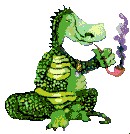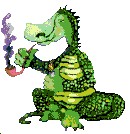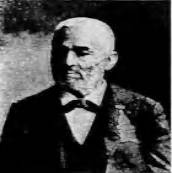 HARIAM'S CASTLE
HARIAM'S CASTLE

 HARIAM'S CASTLE
HARIAM'S CASTLE

| HOME | CASTLE | CHWR | DOVE | IBEW | |
| POEMS | ESOTERIC | SUMNER | MY MASONIC HISTORY PAGE | MY MASONIC PAPERS PAGE | |
| MASONIC GRAPHICS WEB PAGES | COMMUNITY PAGE | CERTIFICATES PAGE | EBONY ANGEL'S WEB SITES | LODGE |
|
GRAND MASTER of MASONS of MISSOURI, PHA
These are just a few of the pieces of the story of a Past Master that
only has a one-line entry in the History of my Lodge.
These are just a few of the pieces of the story of a Past Grand Master
that only has his name entered four times in the History of my Grand
Lodge.
Doing this paper has given new meaning to the saying, "In search of
that which was lost". How many more "Lost Stories" are there in the
History of Masonry that has just been lost over time? How many more
of these stories will I come up with just going through the names in
the History of my own Lodge? Is there an "Untold Story" waiting to be
found in your Lodge?
 In recognition of his many contributions (including the relocation of 16,000 freed slaves, and co-founding what is now Lincoln University), the cemetery was dedicated and named for Father Dickson. It stands as a tribute to his belief that..........as individuals and as a people, we can make a difference.
He was one of the founders of Lincoln Institute, which is now Lincoln
University in Jefferson City, Missouri. Later Lincoln University
experienced many of the same problems the Colored School endured. In
fact, the first enrollees at the Institute, only 2, attended school
in the same shanty on Hobo Hill the black school students attended.
The school was in financial trouble throughout the Reconstruction
period. It was necessary on many occasions for such men as John Lane,
Moses Dickson and J. Milton Turner to act as agents on behalf of the
Institute for the purpose of soliciting contributions. The primary
supporters of the school in those years were the Freedman's Bureau,
the Western Sanitary Commission, various churches and individuals,
both Negroes and liberal whites.
Dickson's efforts aided the Underground Railroad until the Civil
War began, when they enlisted in the Union Army. Dickson later became
an ordained minister of the African Methodist Episcopal Church preached
at several churches in the St. Louis area.
In January of 1865, a state provision banned slavery and required that
all school boards support education for African-Americans. When the
academic year started, St. Louis had five schools with 1,600 black
students. Local African Americans, such as James Milton Turner, Moses
Dickson, John Wheeler, and John Turner led the creation of the
Committee of Twenty-Five in 1879, which was organized to help provide
temporary housing for the 10,000 or so travelers that came through St.
Louis. In the 1904 Olympics held in St. Louis, runner George Pogue
became the first black man to compete in the games.
He served as president of the Refugee Relief Board in St. Louis, which
helped to feed, shelter relocated 16,000 former slaves who were
immigrating to Kansas.
The Committee split in mid-April: the Colored Refugee Relief Board
worked on finding housing and transportation, while the Colored
Immigration Aid Society raised money to form new black colonies in
the west. Most Exodusters moved to the plains of western Kansas,
eastern Colorado, and southern Utah; others stopped in St. Louis.
The city's black population increased by 1880 to 6.36 percent of the
total, many of whom were migrants.
The Most Worshipful Prince Hall Grand Lodge of Missouri, F.&A. M.
Moses Dickson was the sixth Worshipful Master of Prince Hall Lodge #1
and he served two years, 1863 and 1864. He was the first Grand
Lecturer of the Grand Lodge when it was organized on February 8, 1865.
He went on to become the 2nd Grand Master of Prince Hall Masons in
Missouri in 1869 and was elected to that position again in 1877. The
records also show him as the Grand Secretary in 1869 which was the same
year he was Grand Master.
Fraternal organizations provided one response to the flow of new black
arrivals and the racism they encountered. Like their counterparts for
whites, these groups combined aspects of social clubs and benevolent
societies. Prince Hall No. 10 (named for the first black Mason, Prince
Hall, who joined in Boston in 1775) was the first to open in St. Louis,
followed by Lone Star No. 22 three years later and H. McGee Alexander
No. 8 in 1860. At the end of the Civil War, the lodges successfully
petitioned their parent organization, the Ohio Grand Lodge, to create
their own Grand Lodge of Missouri.
By 1909 there were nine black Freemasons Chapters in the city, and the
Negro Masonic Hall Association raised enough money to purchase its own
building. The groups moved from their rented quarters to Easton Avenue
(now Dr. Martin Luther King, Jr., Boulevard). Members of these Lodges
included some of the most prominent members of the local African-American
community. The Masons helped black immigrants find jobs and places to
live, offered needed relief, contributed to charities, backed education,
and promoted the Horatio Alger-style values of honesty and good work.
Companion Moses Dickson was elected Deputy Grand High Priest of the
Grand Chapter of Holy Royal Arch Masons of Missouri and Jurisdiction
in 1876, however he never served as an actual Grand High Priest,
because he became Grand Master for the State of Missouri, and he was
made an Honorary Past Grand High Priest.
The Ritual Heroines of Jericho was written and entered according to
Act of Congress in the year 1895, by Moses Dickson in the Office of
the Librarian of Congress, at Washington, DC. It was printed and sold
by The Moses Dickson Regalia and Supply Co., Kansas City, Missouri.
It contains the "Master Mason's Daughter", "True Kinsman", and
"Heroines of Jericho" degrees. It is a small book of seventy-two pages.
Which makes it the oldest Ritual written by a Prince Hall Mason I have
been able to find to date.
The Knights of Liberty was a secret African American organization,
reportedly organized by twelve black men meeting privately in St.
Louis, Missouri in August 1846. They were also known as the Knights of
Tabor or the International Order of Twelve. Their goal was nothing less
than the destruction of slavery. Their plans are unverified, but it is
likely they were planning to undertake some kind of military action.
The Knights took the name Tabor from the Bible. Tabor is a mountain
in northern Israel where an army of God's people, the Israelites, won
a decisive victory over their enemies, the Canaanites.
The Knights claimed a peak membership of nearly 50,000, and they
estimated that over ten years they helped some 70,000 slaves escape
from slavery over the clandestine Underground Railroad.
Apparently the Knights abandoned their plans in 1856 because they
believed that tensions between the free North and the slave South
were leading to a national civil war that would bring slavery to an
end. Following the Civil War, the leaders founded a benevolent
fraternal society called the International Order of the Twelve Knights
and Daughters of Tabor.
Moses Dickson was also the author of "International 777 Order of
Twelve 333 of Knights and Daughters of Tabor. This book was entered
according to Act of Congress, in the year 1894, by Moses Dickson in the
office of the Librarian of Congress, at Washington, DC. This book
contains the Constitution and Rules and Regulations of Subordinate
Temples of the Uniform Rank of Tabor and Taborian Division.
Moses Dickson was the power behind the Knights and may have been its
actual founder. Born free in Cincinnati, Ohio, in 1824, he saw at first
hand the horrors of the slave system when he worked on a steamboat that
traveled south. He was a soldier in the Civil War and devoted himself
afterwards to racial causes. He became an active Republican and a member
of the Equal Rights League, organizations committed to the freed people.
He also became an AME minister, a founder of Lincoln University in
Missouri, and president of the Refugee Relief Board in St. Louis, which
aided African Americans on their way seeking greater freedom in Kansas
and the West. Although little is known about the Knights when they were
a secret society, their very existence shows the involvement of African
Americans themselves in the struggle for black freedom.
If the War of the Rebellion had not occurred just at the time that it
did, the Knights of Liberty would have made public history.
In 1857 Dickson realized that the Civil War was inevitable, so he changed the focus of the Knights from insurrection to the Underground Railroad. St. Louis was Moses Dickson's headquarters and became a major way station of the Underground Railroad. During the war, when Lincoln decided to allow Blacks to enlist in the Union Army, Moses Dickson was ready with 47,000 men. These Knights of Liberty were already well drilled and completely devoted to the cause of freedom. They pledged themselves to win or die in the attempt. A fraternal organization known as the International Order of Twelve, Knights of Tabor is the successor to the Knights of Liberty. Its purpose is to continue the fight for equality.
845 S. Sappington Road
As one of the first public cemeteries available to Black people in the
St. Louis area, Father Dickson Cemetery was the site of 6,000 burials
before it closed in the 1970's. Without a perpetual care endowment,
the cemetery fell victim to abuse and neglect. Friends of Father
Dickson Cemetery organized in 1988 to repair, restore and preserve the
Historic site. Their vision was to reclaim the natural beauty of this
local landmark, and prevent the loss of its Historic value to commercial
development. Father Dickson Cemetery, named for nineteenth-century
minister Moses Dickson, is now on Sappington Road. Buried there are
the first American Ambassador to Liberia James Milton Turner and
founder of Lincoln University, John Vashon, renowned attorney,
linguist and teacher for whom Vashon High School in St. Louis City is
named after, Henry Lewis, popularly know as "Steamboat", an entrepreneur
and personal barber to Augustus Busch, Sr., and Madame C. J. Walker.
Besides their notable achievements, these Missourians have something
else in common:
Moses Dickson died on Nov. 28, 1901.
FRIENDS OF FATHER DICKSON CEMETERY
Karen Mozee, Vice-President
Friends of Father Dickson Cemetery
BY:
The African American Registry
OFFICIAL MANUAL State of Missouri, 1973-1974
The Role of the Negro in Missouri History
Slavery in St. Louis, By Scott K. Williams, Florissant, Mo.
Soul of America
Amazing Africana Black History Facts
Neighbors and Neighborhoods of North St. Louis
Ritual Heroines of Jericho
Proceeding of the Most Worshipful Prince Hall Grand Lodge of Missouri,
PHA.
History of Prince Hall Lodge #1
International 777 Order of Twelve 333 of Knights and Daughters of Tabor
|